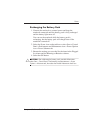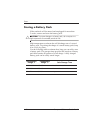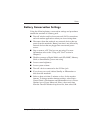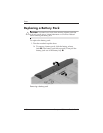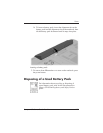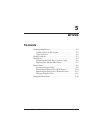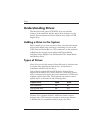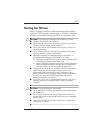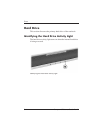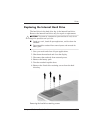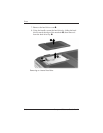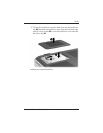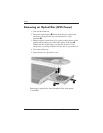
Drives
Startup and Reference Guide—Part 2 5–3
Caring for Drives
Drives are fragile notebook components that must be handled
with care. The following cautions apply to all drives. Additional
cautions are included with the procedures to which they apply.
Ä
CAUTION: To prevent loss or damage to the notebook or a drive:
■ Handle a drive carefully. Do not drop it.
■ When inserting a drive, use only enough pressure to seat the drive.
Excessive force can damage drive connectors.
■ Do not spray a drive with a cleaner or other liquid or expose it to
temperature extremes.
■ Do not remove the primary hard drive (the hard drive in the hard
drive bay) except for repair or replacement.
■ Electrostatic discharge can damage electronic components. To
prevent electrostatic damage to the notebook or a drive:
❏ Discharge yourself from static electricity before handling a drive
by touching a grounded metal object, and
❏ Avoid touching the connectors on a drive. For more information
about preventing electrostatic damage, refer to the Regulatory
and Safety Notices on the Documentation Library CD.
■ Avoid exposing a hard drive or a diskette to devices with magnetic
fields. Security devices with magnetic fields include airport
walk-through devices and security wands. The airport security
devices that check carry-on luggage, usually while it is placed on a
conveyor belt, use x-rays instead of magnetism and will not
damage a hard drive or a diskette.
■ If you mail a drive, ship it in packaging that protects it from shock,
vibration, temperature, and high humidity. Label the package
“FRAGILE.”
Ä
CAUTION: To prevent damage to drive media:
■ Do not open the metal shutter of a diskette or touch the disk within
the diskette case.
■ Do not expose a diskette to a strong magnetic field, such as the
security field used by a walk-through security device or a handheld
security wand.
■ Clean a CD or DVD only with a disc cleaning kit, available from
most electronics retailers.



